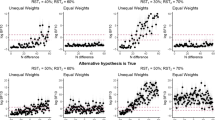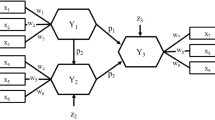Abstract
Research suggests that choice models conditioned on correctly identified consideration sets outperform choice models conditioned on the awareness set (Hauser, 1978; Roberts and Lattin, 1991). However, in data-sparse environments, where purchase history information is not available or not relevant, choice models conditioned on the consideration set often yield nonunique or nonsignificant solutions. In these environments, we propose the use of similarity information to improve the performance of choice models. Support for this position is found in an empirical application involving automobiles.
Similar content being viewed by others
References
Andrews, Rick L., and T. C.Srinivasan. (1995). “Studying Consideration Effects in Empirical Choice Models Using Scanner Panel Data.” Journal of Marketing Research 32 (February), 30–41.
Fiske, Susan T., and Mark A.Pavelchak. (1986). “Category-Based vs. Piecemeal-Based Affective Responses: Developments in Schema-Triggered Affect.” In Richard M.Sorrentino and E. ToryHiggins (eds.), Handbook of Motivation and Cognition (pp. 167–203). New York: Guilford.
Hauser, John R. (1978). “Testing the Accuracy, Usefulness, and Significance of Probabilistic Choice Models: An Information Theoretic Approach.” Operations Research 26, 406–421.
Hauser, John R., and Stephen P.Gaskin. (1984). “Application of the ‘Defender’ Consumer Model”. Marketing Science 3(4), 327–351.
Hauser, John R., and BirgerWernerfelt. (1990). “An Evaluation Cost Model of Consideration Sets.” Journal of Consumer Research 16 (March), 393–408.
Johnson, Eric J., and Robert J.Meyer. (1984). “Compensatory Models of Non-Compensatory Choice Processes: The Effect of Varying Context.” Journal of Consumer Research 11 (June), 528–541.
Johnson, Michael D. (1988). “Comparability and Hierarchical Processing in Multialternative Choice.” Journal of Consumer Research 15, (December), 303–314.
Kalwani, Manohar U., Robert J.Meyer, and DonaldMorrison. (1994). “Benchmarks for Discrete Choice Models.” Journal of Marketing Research 31 (February), 65–75.
Kamakura, Wagner A., and Gary J.Russell. (1989). “A Probabilistic Choice Model for Market Segmentation and Elasticity Structure.” Journal of Marketing Research 26 (November), 379–390.
Kardes, Frank R., Gurumurthy, Kalyanaram, Murali, Chandrashekaran, and Ronald J.Dornoff. (1993). “Brand Retrieval, Consideration Set Composition, Consumer Choice, and the Pioneering Advantage.” Journal of Consumer Research 20 (June), 62–75.
Lehmann, Donald R., and YigangPan. (1994). “Context Effects, New Brand Entry, and Consideration Sets.” Journal of Marketing Research 31 (August), 364–374.
Nedungadi, Prakash. (1990). “Recall and Consumer Consideration Sets: Influencing Choice Without Altering Brand Evaluations.” Journal of Consumer Research 17 (December), 245–253.
Payne, John W., James R.Bettmann, and Eric J.Johnson. (1993). The Adaptive Decision Maker. New York: Cambridge University Press.
Ratneshwar, S., and Allan D.Shocker. (1991). “Substitution-in-Use and the Role of Usage Context in Product Category Structures.” Journal of Marketing Research 28 (August), 281–295.
Roberts, John H., and James M.Lattin. (1991). “Developing and Testing of a Model of Consideration Set Composition.” Journal of Marketing Research 28 (November), 429–440.
Rossi, Peter E., and Greg M.Allenby. (1993). “A Bayesian Approach to Estimating Household Parameters.” Journal of Marketing Research 30 (May), 171–182.
Shocker, Allan D., MosheBen-Akiva, BrunoBoccara, and PrakashNedungadi. (1991). “Consideration Set Infleunces on Consumer Decision-Making and Choice: Issues, Models, and Suggestions.” Marketing Letters 2(3), 181–197.
Silk, Alvin J., and Glen L.Urban. (1978). “Pre-Test-Market Evaluation of New Packaged Goods: A Model and Measurement Methodology.” Journal of Marketing Research 15 (May), 171–191.
Simonson, Itamar, Stephen, Nowlis, and Katherine, Lemon. (1993). “The Effect of Local Consideration Sets on Global Choice Between Lower Price and Higher Quality.” Marketing Science 12 (Fall), 357–377.
Smith, Edward E., and Douglas L.Medin. (1981). Categories and Concepts. Cambridge, MA: Harvard University Press.
Sujan, Mita (1985). “Consumer Knowledge: Effects on Evaluation Strategies Mediating Consumer Judgments.” Journal of Consumer Research 12 (June), 16–31.
Urban, Glen L., John S.Hulland, and Bruce D.Weinberg. (1993). “Premarket Forecasting for New Consumer Durable Goods: Modelling Categorization, Elimination, and Consideration Phenomena.” Journal of Marketing 57 (April), 47–63.
Author information
Authors and Affiliations
Rights and permissions
About this article
Cite this article
Hulland, J., Vandenbosch, M. Estimating choice models in data-sparse environments: Taking advantage of perceived similarity. Market Lett 7, 329–339 (1996). https://doi.org/10.1007/BF00435540
Issue Date:
DOI: https://doi.org/10.1007/BF00435540




